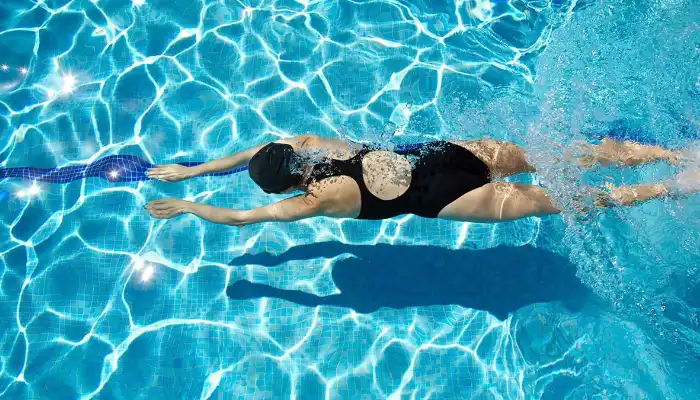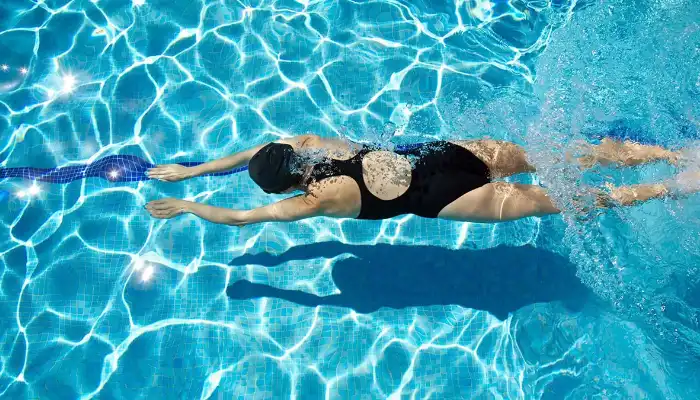
Sometimes, it can be difficult to find time for physical exercise, especially when one is tied up with other things. However, what if there was something that could finish off the fitness routine without doing many different exercises? Look no further than swimming! Perceived as a leisure activity, swimming is an excellent way to work out your entire body. It has all the characteristics of a cardio workout that leaves you invigorated and refreshed.
This article will discuss how swimming works and how various strokes engage different muscle groups. We will also consider why it’s great for cardiovascular health in relation to other popular forms of cardio exercises. Finally, we shall explore how swimming enhances your existing fitness program by strengthening other parts of your body while improving flexibility.

The Symphony of Swimming: Engaging Your Entire Body
Swimming is unlike most other physical activities, which target specific muscles, as it involves all limbs. Below is an example of how different types of strokes involve the core muscles and upper or lower extremities:
- Freestyle (Front Crawl): This is the most popular kind of stroke. It uses abdominal muscles for rotation and stability as one constantly propels himself/herself through water using hands, back, and feet.
- Backstroke: Another name for this stroke is supine swimming since it enables individuals to swim on their backs rather than stomachs, meaning that one’s core performs more stabilization roles. Sculling motions involve forearms moving backwards, making them stronger together with the lats and triceps, while propulsion is achieved using leg kicks, thereby working the glutes, hamstrings, and quadriceps.
- Breaststroke: For example, the chest, shoulders, and triceps are all responsible for the strong pulls made during this type of swim. Legs perform frog-style kicks, thereby utilizing quads and hamstring glutes, respectively.
- Butterfly: Out of all the others, this one proves to be so difficult because, apart from having good central strength, anybody who can manage it perfectly should have strong coordination; otherwise, it cannot be achieved. During this stroke, the arms need to be aligned together with the chest and back for undulating movements, while the core and leg muscles are worked during a strong dolphin kick.
A Cardio Champion: Strengthening Your Heart and Lungs
Swimming can be a highly effective cardiovascular exercise that gets your blood flowing and helps raise your overall level of fitness. In addition, here is what happens:
- Rapid heart rate: It helps to go into the target zone due to higher cardiac health along with better stamina.
- Elevated Oxygen Consumption: Continuous motion underwater makes it harder for you to breathe, which in turn causes increased lung capacity, improving your body’s maximum oxygen intake during exercise.
- Low-impact exercise: Unlike high-impact exercises such as running, swimming does not damage connective tissues, making it ideal for people of all fitness levels, including those undergoing rehabilitation after an accident or surgery.
Swimming is more dynamic than cycling or rowing since it works on more muscles but still gives an equivalent cardio workout.
Building Strength Like a Fish: Resistance Training in the Water
One of the reasons why swimming is considered one of the best ways to increase muscle strength and tone all over your body is because water itself provides natural resistance. Some examples of them are:
- Resistance Training: Every stroke made through water becomes hard due to its resistance against any person’s muscle, thereby continuously challenging them.
- Core Connection: If swimming is executed in the right way, the constant engagement of core muscles will also make the abdominal walls and back stronger, thus enhancing training outcomes for both swimmers.
- Complementary Strength Training: In addition to that, swimming complements weight-training programs. This exercise helps develop enduring muscle power without interfering with lifting days.
Swim training can be great for building strength, but there is a need for targeted lifting to add bulk. Nonetheless, swimming is perfect for building functional power as well as overall muscle endurance.
Freedom in Water: Unlocking Flexibility
Flexibility increases with swimming, and the range of motion improves. Here’s what happens:
- Repetitive Motions: Continuous strokes used in swimming can stretch out and elongate muscles, especially the shoulder, back, hip, and leg muscles.
- Increased Range of Motion: Swimming over time leads to increased joint range of motion (ROM), which will enhance flexibility as well as posture generally.
However, it will not flex that much regarding interchangeability with other types, such as yoga or Pilates, targeting specific areas. However, it could be a useful method to maintain flexibility generally and increase the capability of one’s body movement over a wider space range.
Impact of Swimming on Major Muscle Groups
There are hardly any exercises like swimming where almost all major muscle groups participate actively within your body; when you do each stroke, your core, arms, legs, and back work together. It is a low-impact exercise activity compared to high-impact activities such as running or jumping, which are hard on joints, since it does not stress these parts, making it suitable for people with joint problems who have been supporting heavy weights, resulting in injuries or knee pain.
This is how different sections get affected:
- Core: All strokes use the core for stability and force, which consequently strengthens the abs while also reducing the chances associated with lower backaches.
- Upper Body: The action of pulling oneself through water enables the development of strong triceps and pectoral muscles along with a good shoulder girdle. Different strokes work for different muscle groups, thus enhancing variety in upper-body sessions.
- Lower Body: Kicking used during swimming strengthens the quadriceps, hamstrings, and calves in their lower bodies, making them good at cardiovascular training too.
Mental Wellbeing: Beyond the Physical
Swimming has got a lot of health benefits beyond just physical aspects. Often water immersion is very soothing and therapeutic. Moreover, swimming can reduce anxiety and stress levels as well. The repetitive motion of strokes and the rhythmic sound of breathing can lead to a meditative state that encourages relaxation and mindfulness.
Here’s how swimming can help improve your mental health:
- Stress Relief: For a long time now, intense activities have always been known as one of the methods that help relieve stress, especially in swimming due to their calming effect.
- Improved Mood: Physical activity causes endorphins to be released by the body which uplifts the spirit. After a swim, you will always feel happy.
- Combating Anxiety: Breathing techniques in rhythm done while swimming may help control your heart rate as well as soothe your nervous system giving relief from symptoms associated with anxiety disorders.
Accessible and Convenient
Swimming is a kind of exercise that anybody can undertake at any place. In contrast to other sports that have specific gear or unique outdoor locations, swimming is possible any time in most parts of the world and every year round making it ideal for you if;
- Public Pools and Gyms: Many towns are equipped with public pools as well as gyms which have the necessary facilities for swimming hence making it accessible to many individuals.
- Year-Round Activity: With indoor activities that are not influenced by weather patterns like swimming done indoors in heated pools, it is possible to swim all year around.
- Low-Cost Exercise: It’s relatively cheaper as compared to some fitness programs or equipment that keeps one active.
Alternatives for Limited Pool Access:
However, there are other ways of doing water exercises without having a pool. Here are some options:
- Open Water Swimming: This is great exercise for those who are expert swimmers but good friend systems must be used and checking of water conditions must not be ignored for safety reasons.
- Shallow Water Exercises: But shallow-water workouts can still be powerful. Squat, lunge and do bodyweight exercises while sinking into shallow waters that can strengthen your muscles and offer low-impact benefits too.
- Aqua Fitness Classes: Several local gyms and community centers have aqua fitness classes that use water resistance to make exercising enjoyable.
Conclusion
Swimming is a well-rounded sport that has numerous advantages for our physical and mental health. It is easy on the joints yet boosts cardiovascular fitness, and lowers stress levels and anxiety. This makes it a perfect addition to your regimen since you can access it throughout the year. So why don’t you jump right in? It might just turn out to be your best way of remaining healthy and happy from then on.
